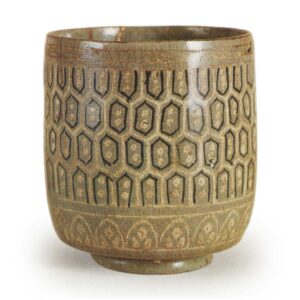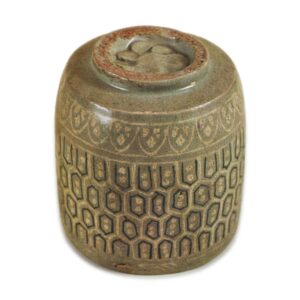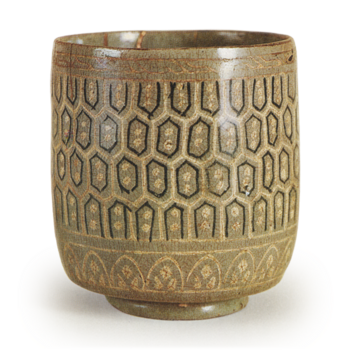

Height: 9.3-9.4cm
Diameter: 8.4-8.5cm
Outer diameter of foot: 5.2-5.3cm
Height of foot: 0.6-0.7cm
This is one of the oldest of the so-called Koryo tea bowls that have survived to the present day, and was probably made in the latter half of the Koryo period. It is therefore of the same type as the so-called Ko-Unkaku or Kyogen Hakama tea bowls, but this one is even older, and there are no other tea bowls that have survived to the present day that better convey the dignity of Koryo inlaid celadon.
By the way, it seems that this type of cylindrical tea bowl was much admired from the end of the Muromachi period to the Momoyama period, and the famous “Hikigasa” owned by Sen no Rikyu is almost the same shape as this, and is a tea bowl called “Kyogen Hakama”, and he also owned a “mishima-tsubo” tea bowl, so it is thought that Rikyu was particularly fond of this type of tea bowl, and it is also possible that the Setoguro tea bowls that are said to be Rikyu’s favorite also imitated the shape of this type of tea bowl.
As mentioned above, this tea bowl is the oldest of the surviving Korean tea bowls, so it is thought that it may have been brought over from Korea in a fairly old period, but the inner box is not that old, and moreover, the writing on it is in the handwriting of Enshu, and it is written “Mishima tea bowl”. However, this tea bowl is clearly not a Mishima-te, but a so-called Koryo tea bowl, and if we were to add it to the ancient classification, it would belong to the Ko-Unkaku-te category. The reason it is called a Mishima is probably because the pattern is different from Unkaku and Kyogen hakama, and it was named after the color of the glaze, which is somewhat similar. Because the workmanship is so neat and orderly, some people think it lacks the flavor of a wabi tea bowl, but it is certainly a famous bowl that can stand on its own in a place of appreciation, rather than a wabi tea bowl, and it has extremely high documentary value as an old-style Korean tea bowl.
The clay body is probably the grayish-white characteristic of Koryo celadon, but there is no exposed clay. The foot ring is covered with sand, creating a so-called sand foot ring. The foot ring is relatively large and has been simply carved out, but what is interesting is the way it has been made inside the foot ring, with the petals created with the fingertips so that it looks like a seven-petaled flower, and I don’t know of any other examples like this.
The white and black inlaid pattern on the outside is made up of a twenty-petal lotus flower pattern with a white inlay at the base, and a so-called “tortoise shell” pattern made up of twenty-six pieces of white and black inlay on each of the four levels. The tortoiseshell pattern is often seen in inlaid celadon from the late Goryeo period, but it is rare to find one that is so finely and neatly inlaid. Furthermore, this is the only example of a tea bowl that I have seen. The rim is inlaid with a white inlaid thunder pattern, and the celadon glaze that covers the entire piece is quite thick, with cracks appearing throughout.
Although not visible on the outside, the upper half of the inside is decorated with five concentric bands of lathe marks, which add to the deep, cylindrical feel of the tea bowl. There is also ash on the inside.
There is some damage and repair work, but there is one crack from the rim to the base, and four cracks halfway up the body.
The accessory bag is made of brown satin with a camellia flower arabesque pattern. It is not clear when it was made.



